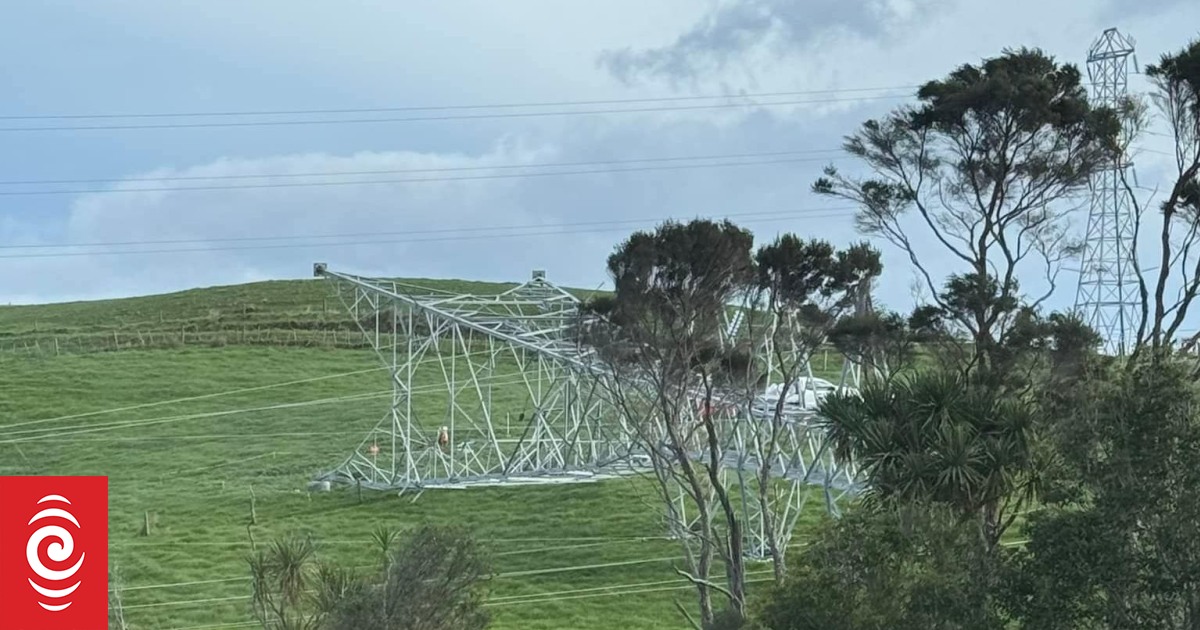
Transpower and its contractor Omexom have agreed to pay $1 million towards projects benefiting Northland following the collapse of a power pylon earlier this year.
Photo: Supplied / Kawakawa Electrical Ltd
Transpower and its contractor Omexom will make a $1 million payment to projects benefiting Northland following the collapse of a power pylon earlier this year.
On 20 June, Omexom workers carrying out routine maintenance on a pylon north of Auckland unbolted three of its four legs at once.
When the pylon toppled over, power was cut to 88,000 Northland homes and businesses. Estimates for the region’s financial loss range from $37.5m to $80m.
The $1m payment, plus measures to improve energy resilience in Northland, was due to be announced in Whangārei at 2pm on Wednesday.
Northland MP Grant McCallum, who has pushed Transpower for some form of reparation, was to make the announcement, along with Whangārei Mayor Vince Cocurullo and Transpower acting chief executive John Clarke.
McCallum described the $1m as a “goodwill payment” because neither Transpower nor Omexom were under any legal obligation to pay compensation.
The money would be managed by regional development agency Northland Inc and allocated to “resilience initiatives and projects that will deliver long-term economic benefits for the people and businesses of Northland”.
Northland Inc chief executive Paul Linton said a panel of Northland community leaders, along with Transpower and Omexom representatives, would decide which projects received funding.
More details of how it would work would be revealed in coming weeks, he said.
Other measures due to be announced this afternoon are the development of plans for improving the reliability of Northland’s power supply, and for unlocking the region’s renewable energy potential.
“Transpower’s tower fall and ensuing power outage in June has created heightened awareness of the resilience risk to Northland’s electricity network,” McCallum said.
“This package of initiatives is a step in the right direction to addressing that risk and moving the region forward.”
The Regional Resilience and Reliability Plan would be developed by national grid operator Transpower and local lines companies Top Energy and Northpower.
Transpower’s acting chief executive John Clarke said the plan would identify practical options for increasing the resilience of electricity transmission and distribution networks in Northland, and was expected to be completed before the end of the year.
He said regional strategies had worked well overseas, where they had quickly increased energy supplies.
The Northland Corporate Group, which brings together Whangārei’s biggest businesses, backed the concept, which had been dubbed the “Energy Bridge”.
Whangārei Mayor Vince Cocurullo, who also chairs the Northland Mayoral Forum, said the region was blessed with natural resources that could be used to generate renewable electricity.
“New generation from renewable sources such as solar, wind and geothermal energy can play an important role for Northland’s energy resilience and for its economic development. Northland is in in a position where it could generate more than it needs and become an exporter of electricity to Auckland,” he said.
The Far North is already a net exporter of energy thanks to a geothermal power station at Ngāwhā, near Kaikohe, and New Zealand’s largest solar farm, near Kaitāia.
Just last month Meridian announced plans for an even larger solar farm, plus a battery storage facility, at Ruakākā, south of Whangārei. https://www.rnz.co.nz/news/national/529428/consent-granted-for-large-solar-power-station-at-ruakaka-in-northland
RNZ understands the $1m payment does not preclude any businesses from trying to seek compensation via class action.
Northland’s biggest electricity users, such as Fonterra’s two dairy plants, the JNL timber mill in Kaitāia, and Golden Bay Cement in Portland, agreed to close for several days after the pylon collapse to ensure there was enough power for domestic users.
Many hospitality businesses also suffered losses when they had to throw out food that could not be kept refrigerated.



